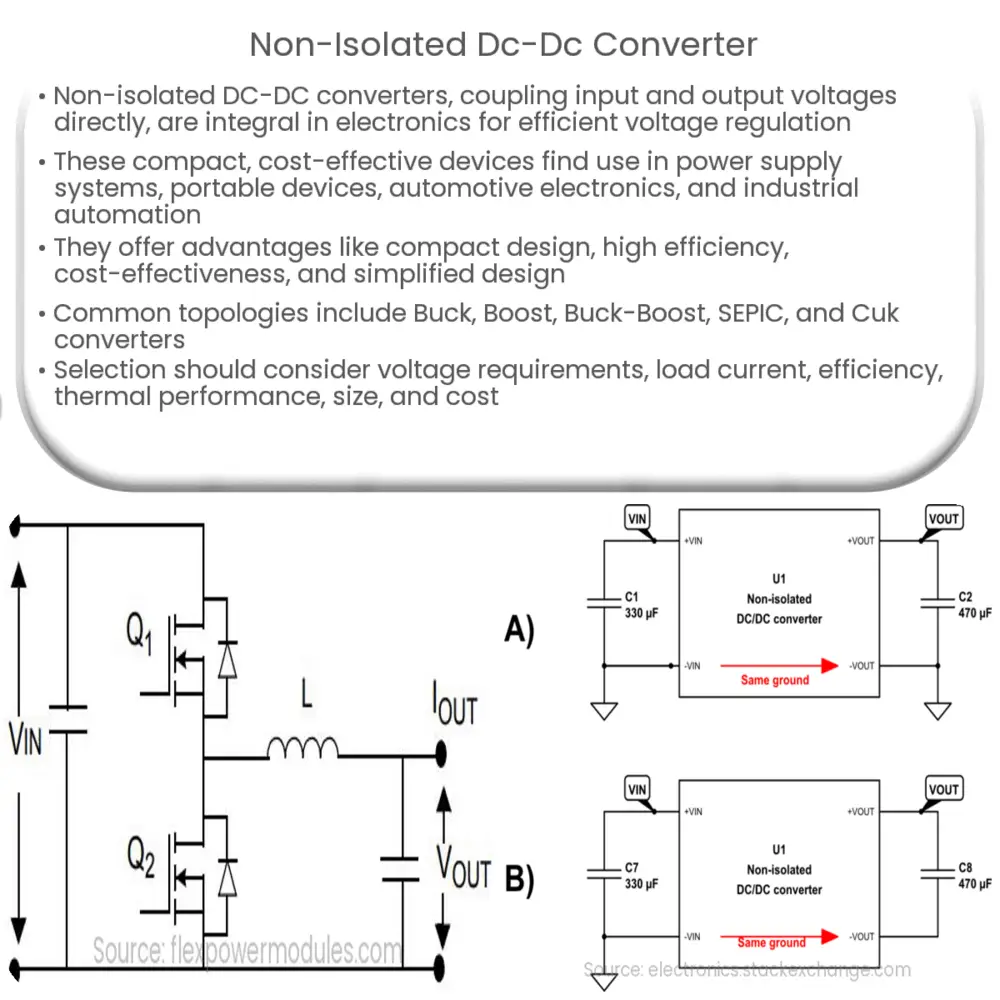Non-isolated DC-DC converters efficiently regulate voltage in electronic systems, offering compact design, high efficiency, and cost-effectiveness.

Non-Isolated DC-DC Converters: An Overview
Introduction
DC-DC converters are essential components in modern electronic devices and systems. They play a vital role in efficiently converting and regulating the voltage levels between different parts of a circuit. DC-DC converters can be broadly classified into two categories: isolated and non-isolated. This article focuses on non-isolated DC-DC converters, highlighting their applications, advantages, and common topologies.
What are Non-Isolated DC-DC Converters?
Non-isolated DC-DC converters are power electronic devices that directly couple the input and output voltages without any galvanic isolation between the two. In other words, there is no physical barrier that separates the input and output, allowing for a more compact and cost-effective design. The primary function of non-isolated converters is to step up or step down the voltage level in a power supply system while maintaining high efficiency and power density.
Applications of Non-Isolated DC-DC Converters
Non-isolated DC-DC converters are widely used in a range of applications, including:
- Power supply systems: They are commonly used in distributed power systems and point-of-load (POL) applications, where multiple voltage levels are required to power different components of an electronic system.
- Portable devices: Non-isolated converters are found in smartphones, tablets, and laptops, where they help to maintain optimal battery life and improve energy efficiency.
- Automotive electronics: These converters are used in electric vehicles and other automotive systems to manage the power distribution between various subsystems and components, such as lighting, infotainment, and engine control modules.
- Industrial automation: Non-isolated converters are employed in motor drives, programmable logic controllers (PLCs), and other industrial control systems to ensure stable and efficient power conversion.
Advantages of Non-Isolated DC-DC Converters
Some key benefits of non-isolated DC-DC converters include:
- Compact design: Due to the absence of isolation transformers, non-isolated converters are typically smaller and lighter than their isolated counterparts, making them suitable for applications with space constraints.
- High efficiency: Non-isolated converters generally exhibit higher efficiency levels compared to isolated converters, as there are fewer energy losses associated with transformer components.
- Cost-effectiveness: Eliminating the need for isolation components allows for a more cost-effective solution, especially for high-volume production applications.
- Simplified design: Non-isolated converters have a less complex circuit design, which can lead to reduced design time and faster time-to-market for new products.
Common Topologies of Non-Isolated DC-DC Converters
There are several widely used non-isolated DC-DC converter topologies, including:
- Buck converter: Also known as a step-down converter, the buck converter reduces the input voltage to a lower level at the output.
- Boost converter: This topology steps up the input voltage to a higher level at the output, making it a step-up converter.
- Buck-boost converter:
The buck-boost converter can either step up or step down the input voltage based on the specific requirements of the application. - SEPIC converter: The Single Ended Primary Inductor Converter (SEPIC) is a versatile topology that can operate in both buck and boost modes, and is particularly useful when input and output voltages are close to each other.
- Cuk converter: The Cuk converter is another topology that can perform both step-up and step-down operations, with the added advantage of low output voltage ripple.
Selection Criteria for Non-Isolated DC-DC Converters
When choosing a non-isolated DC-DC converter for a particular application, several factors should be considered:
- Input and output voltage requirements: The converter must be capable of handling the required voltage levels for the specific application.
- Load current: The converter should be able to deliver the necessary current to the load without exceeding its maximum output current rating.
- Efficiency: Higher efficiency levels result in less energy loss and lower operating temperatures, which can extend the lifespan of the converter and other components in the system.
- Thermal performance: Proper thermal management is crucial for ensuring reliable operation and preventing damage to the converter and surrounding components.
- Size and form factor: The converter should fit within the space constraints of the application and be compatible with the overall system design.
- Cost: The overall cost of the converter should be considered, especially for high-volume production applications where cost savings can have a significant impact on profitability.
Conclusion
Non-isolated DC-DC converters are essential building blocks in a wide range of electronic systems, offering compact design, high efficiency, and cost-effectiveness. By understanding the different topologies and selection criteria, engineers can choose the appropriate converter for their specific application, ensuring reliable and efficient power conversion. As technology continues to evolve, non-isolated DC-DC converters will remain a critical component in the design of next-generation electronic devices and systems.

